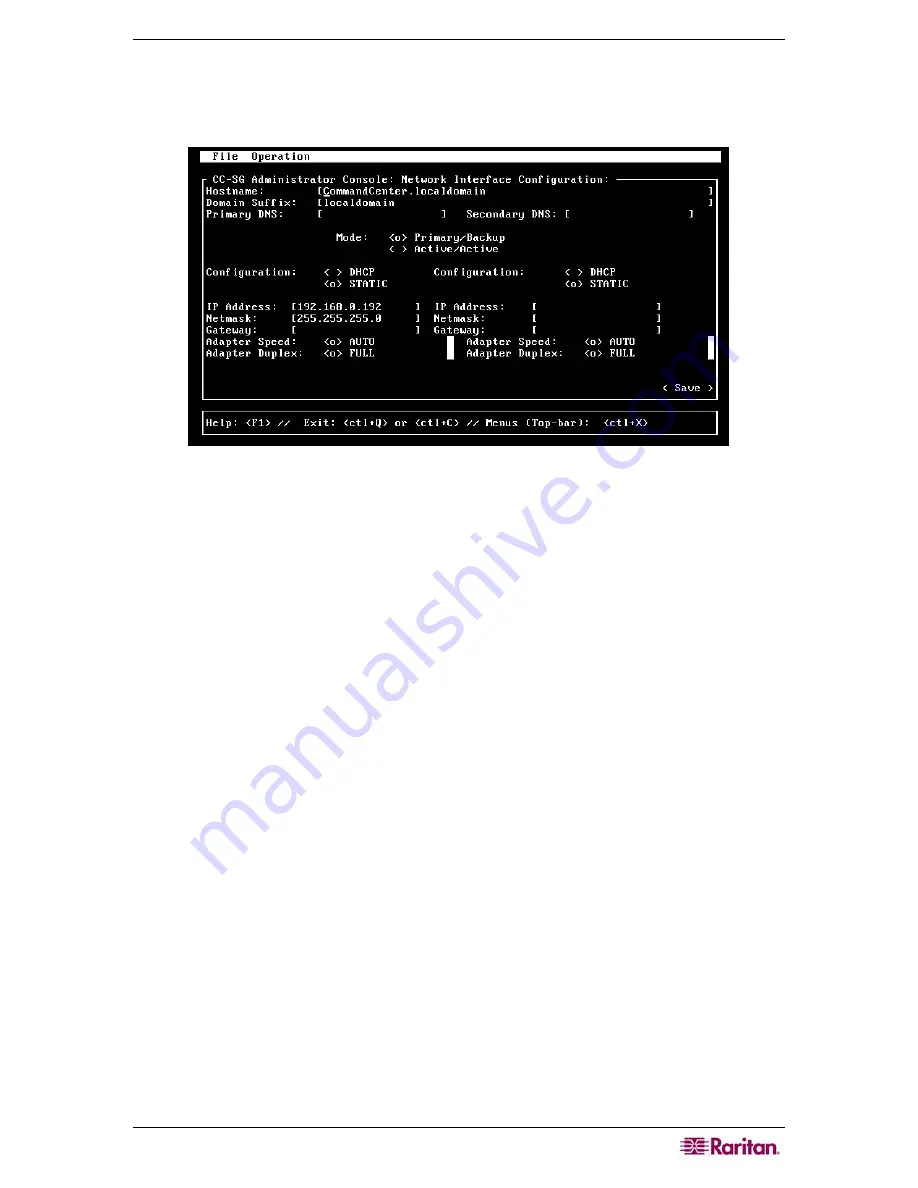
C
HAPTER
12:
A
DVANCED
A
DMINISTRATION
195
2.
If the network interfaces have already been configured, you will see a
Warning
message
stating that you should use the CC-SG GUI (administrator’s Director Client) to configure the
interfaces. If you want to continue, click
YES
. The default Network Interface Configuration
screen is shown here:
Figure 195 Editing Network Interfaces
3.
Type your hostname in the
Host Name
field. After a save, this field will be updated to reflect
the Fully-Qualified Domain Name (FQDN), if known. For hostname rules, please refer to
Terminology/Acronyms
in
Chapter 1: Introduction
.
4.
In the Mode field, select either
Primary/Backup Mode
or
Active/Active Mode.
Please refer
to
Network Configuration
earlier in this chapter for details. Press the
TAB
key to select the
field, and then press the arrow keys to select between the two modes. To select a mode, press
the
SPACEBAR
key.
5.
Click or
TAB
to the
Configuration Field
and select either
DHCP
or
Static
from the list.
−
If you choose DHCP and your DHCP server has been configured appropriately, the DNS
information, the domain suffix, IP address, default gateway and subnet mask will be
automatically populated once you save, and you exit and re-enter Admin Console.
−
If you choose
Static
, type an
IP Address
(required),
Netmask
(required),
Default
Gateway
(optional),
Primary
DNS
(optional) and
Secondary
DNS
(optional), and
Domain Name in
Domain Suffix
(optional).
−
Even if DHCP is being used to determine the IP configuration for an interface, a properly
formatted
IP address
and
Netmask
must be provided.
6.
TAB
into or click
Adapter Speed
and use the
↓↑
keys to select a line speed from the list.
The other values of 10, 100, and 1000 Mbps are on a scrollable list (where only one value is
visible at any given time) and the
↓↑
keys are used to navigate to them and <
SPACE
> is
used to select an alternate value (if so desired).
7.
If you did not select
AUTO
for
Adapter Speed
, click
Adapter Duplex
and use the
↓↑
keys
to select a duplex mode (
FULL
or
HALF
) from the list, if applicable. While a duplex mode
can be selected at any time, it only has meaning and takes effect when
Adapter Speed
is not
AUTO
.
8.
Repeat these steps for the second network interface if you selected
Active/Active Mode.
9.
Select
Save
to save your changes. CC-SG will restart, logging off all CC-SG GUI users and
terminating their sessions. A
Warning
screen will be presented informing of the impending
network reconfiguration and associated CC-SG GUI user impact. Select <
YES
> to proceed.
Summary of Contents for CC-SG
Page 2: ...This page intentionally left blank...
Page 26: ...12 COMMANDCENTER SECURE GATEWAY ADMINISTRATOR GUIDE This page intentionally left blank...
Page 46: ...32 COMMANDCENTER SECURE GATEWAY ADMINISTRATOR GUIDE This page intentionally left blank...
Page 158: ...144 COMMANDCENTER SECURE GATEWAY ADMINISTRATOR GUIDE This page intentionally left blank...
Page 228: ...214 COMMANDCENTER SECURE GATEWAY ADMINISTRATOR GUIDE This page intentionally left blank...
Page 236: ......
Page 246: ...232 COMMANDCENTER SECURE GATEWAY ADMINISTRATOR GUIDE...
Page 248: ...234 COMMANDCENTER SECURE GATEWAY ADMINISTRATOR GUIDE...
Page 250: ...236 COMMANDCENTER SECURE GATEWAY ADMINISTRATOR GUIDE...
Page 256: ...242 COMMANDCENTER SECURE GATEWAY ADMINISTRATOR GUIDE...






























